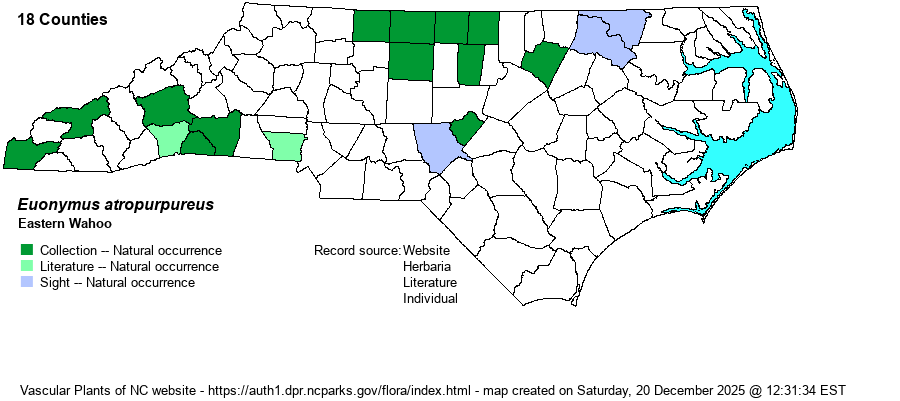| Author | Jacquin | |
| Distribution | Scattered over the northern and far eastern parts of the Piedmont, and in the southern Mountains and adjacent foothills. Also occurs along the upper Roanoke River floodplain in Halifax and Northampton counties. Seemingly absent from most of the western and central parts of the Piedmont, for no obvious reason -- it is present at either edge (northeastern and southwestern). Clearly not present in nearly all of the Coastal Plain and likely also the northern Mountains. Strangely there is a lack of any photos on iNaturalist from wild plants in the state, though thankfully Will Cook has such photos from Caswell and Person counties on his Carolina Nature website.
This species occurs mainly to the northwest of NC, and is found in most counties from OH west to northeastern OK. It ranges north to southern Canada, and south barely to the FL panhandle and central TX. However, records are sparse from NC around the coastal states to TX.
| |
| Abundance | Rare to very locally uncommon in the northern Piedmont, but generally rare over the province as a whole. Uncommon along the upper Roanoke River floodplain. Rare in the southern Mountains, but apparently absent in the northern Mountains and neighboring Piedmont counties. This is an NC Watch List species. | |
| Habitat | This is essentially a requisite “mafic” soil species, occurring almost solely in circumneutral soils. Favored sites are rich natural levee forests along brownwater rivers, but it also occurs in Basic Mesic Forest, Rich Cove Forest, and in the richer portions of bottomland forests away from rivers and creeks. |
| Phenology | Blooms mainly in May, and fruits in October.
| |
| Identification | This is a tall shrub to rarely a small tree, with a single trunk (usually) reaching 15 feet tall on average. The deciduous, opposite leaves have a distinct and relatively long petiole, usually about 1/4-inch long. The leaves are widely lanceolate and have a long, tapered tip; the leaf margins are finely serrate. In addition, the twigs are green, but the larger stems are gray; the similar E. americanus has essentially sessile leaves and has most of the branches green (and not gray). Few people get to see this rare (in the South) species in bloom or fruit, but the flowers and fruits are most unusual and very different from the other Euonymus species. It has medium-sized maroon-purple, 4-petaled flowers in dangling clusters; these are followed in fall by smooth, pink to rose-colored capsules that split open to reveal the several red “berries”. | |
| Taxonomic Comments | Most references have the species in two varieties: var. cheathumii is endemic to just a part of TX, and thus the rest of the species is relegated to the widespread var. atropurpureus. However, Weakley (2018) does not recognize these entities.
| |
| Other Common Name(s) | Burning-bush, American Wahoo | |
| State Rank | S2 | |
| Global Rank | G5 | |
| State Status | W7 [W1] | |
| US Status | | |
| USACE-agcp | FAC link |
| USACE-emp | FACU link |

